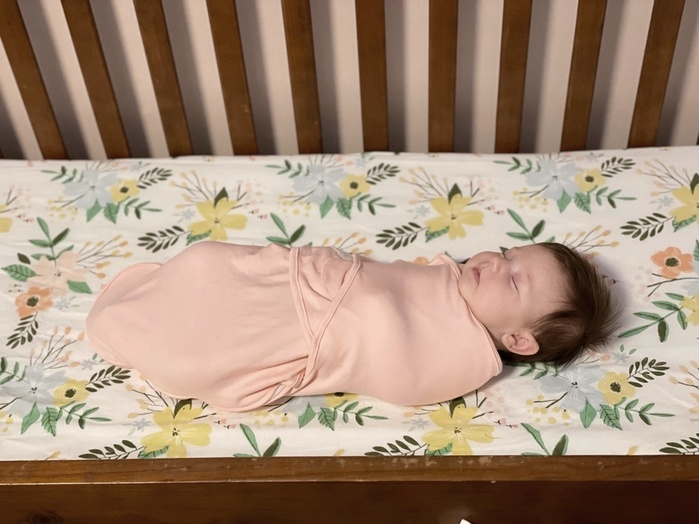Sweet dreams: A guide to infant sleep

While sleep should be peaceful, ensuring your baby is sleeping safely — and soundly — can be stressful.
We spoke with Shana Zandman, MD, a pediatrician at Brookline Pediatrics in the Boston Children’s Primary Care Alliance, and Jennifer Gingrasfield, RN, MSN, a pediatric nurse practitioner in the Sleep Center at Boston Children’s Hospital, about creating a healthy sleep routine and environment for your baby.
How much sleep should my infant get?
“Young babies often spend much of the day sleeping,” explains Dr. Zandman. “Adequate sleep length is essential for normal growth and brain development.”
The amount of sleep your baby should be getting depends on their age. Newborns and infants under 4 months often sleep 14 to 17 hours per day.
Experts at the Sleep Center created this table outlining the standard benchmarks for your child’s sleep. After the first few weeks of life, most children’s sleep times fall within about an hour of those listed.
As your child gets older, the amount of sleep they require decreases. “It is normal for patterns of sleep to change with age,” says Zandman. “Often younger babies fall into a ‘cat nap schedule’ with short rests approximately every 90 min or so.”
As infants grow, their sleep cycles and wake periods gradually lengthen. By around 6 to 8 months old, infants are typically capable of sleeping through the night (about 10 hours) and taking two, 1- to 1.5-hour naps per day. By 15 to 18 months, toddlers are napping once daily in the afternoon and sleeping about 10 hours at night for a total of about 12 hours sleep.
“Adjusting to bringing a newborn home can be really hard,” Dr. Zandman says. “Although babies sleep for large portions of the day, their sleep schedule is more interrupted than an adult’s and this can be difficult for parents to adapt to.”
How can I encourage my infant to sleep through the night?
Introducing a consistent bedtime routine early on could help encourage longer stretches of overnight sleep. “Bedtime routines vary with age but may include dimming the lights at a consistent time each day, bathing, and a special book or song,” explains Zandman.
“When your infant is young, the best time to put them to bed is when they’re drowsy but still awake,” explains Gingrasfield. “This helps to form sleep habits that make it easier for infants to sleep in a crib so they will sleep better at night.” Many families resort to unsafe sleep practices out of desperation and fatigue because the baby is having a hard time sleeping, so it is best to learn safe sleeping habits.
How should my infant sleep?
Ensure your infant is sleeping on their back
Infants should sleep on their back until they are 1 year old. Back sleeping significantly reduces the likelihood of Sudden Unexpected Infant Death Syndrome (SUID). Sleeping on their side makes it easy to roll onto their stomach, so parents should try to roll the baby back onto their back. A parent can swaddle their baby, but be sure the baby’s breathing is not obstructed and keep the swaddling no higher than their shoulders. If your baby tries to roll over in a swaddle, it is a sign to stop swaddling.
Once your baby can roll independently, back to stomach and stomach to back, you do not have to place your baby on their back each time they roll.
Create a safe sleep environment
Infants should sleep on a firm, flat surface, like a crib or bassinet. Be sure that the crib is empty. Some brands of sleep equipment claim to reduce the likelihood of SUID, however, there is no evidence to support this claim. When choosing sleeping equipment, refer to the safety recommendations of the Consumer Product Safety Commission (CPSC). Last October, the CPSC released a statement warning parents to avoid using nursing/lounging pillows for infant sleep. You can find more information from the CPSC about sleep products here.
There should be no blankets, pillows, stuffed animals, or crib bumpers; these could suffocate or strangle your baby. Avoid bundling them up. Infant sleep clothing, like a sleep sack, is a great option if your baby is cold. A good rule of thumb is that the baby should only wear one layer more than you are wearing.
Avoid bed-sharing
“The American Academy of Pediatrics recommends sharing a room — but not a bed — with infants under the age of 1,” suggests Zandman.
Letting your baby sleep in the same bed as you can be dangerous as the baby may overheat or obstruct breathing. Certain conditions make it even more dangerous, including:
- if the baby is younger than 4 months
- if the baby was born prematurely
- if the bedding has pillows or quilts
- if anyone in the bed is a smoker
- if anyone in the bed has had any alcohol or is on any drowsy medications
In conclusion, remember your Safe Sleep ABCs
There are so many considerations that come with safe sleep. To summarize the most important recommendations, Gingrasfield suggests remembering the ABCs of safe sleep:
- A: babies should sleep alone
- B: on their back
- C: in a safe crib, right from the start
When is it time to talk to your pediatrician?
Pediatricians are experienced in best sleep practices and can offer support if your infant is struggling. Parents should call their pediatrician if their infant is:
- waking up frequently during the night
- having difficulty learning to fall asleep or stay asleep on their back
- having frequent fussiness or crying during nap or bedtime
- frequently congested breathing or nighttime cough
- experiencing persistent snoring or breathing pauses during sleep
- making unusual or abnormal movements during sleep
If your infant is having trouble sleeping or you need more specific guidance, find a Boston Children’s Primary Care Alliance practice near you, or contact the Sleep Center.
Related Posts :
-

Which pain medication is right for your child? What a pediatrician wants parents to know
There’s no shortage of safe and effective pain medications for children. Acetaminophen (commonly known as Tylenol), ibuprofen (Motrin, Advil), ...
-

Delving into the causes of attention deficits: Childhood adversity, lost sleep, and dopamine
New research on the effects of adversity in childhood ties together stress, sleep loss, and attention deficits later in life. ...
-

EarlyBird: Addressing dyslexia through game play
Up to 10 percent of the population has dyslexia, yet many children are diagnosed only after struggling with reading for years. ...
-

Four ways to support your teen’s mental health
Being a teen is hard enough, but with the current adolescent mental health crisis, parents should know about the psychosocial ...





